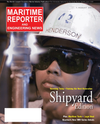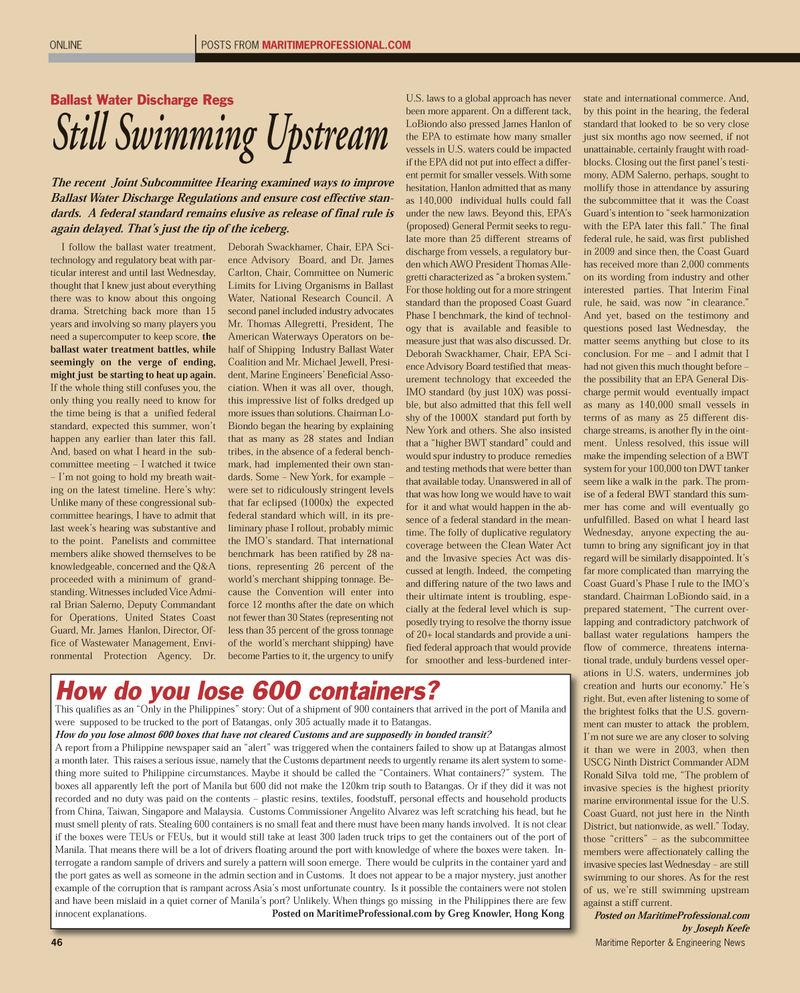
Page 46: of Maritime Reporter Magazine (August 2011)
Top 20 Shipyards of the World
Read this page in Pdf, Flash or Html5 edition of August 2011 Maritime Reporter Magazine
ONLINEPOSTS FROM MARITIMEPROFESSIONAL.COMI follow the ballast water treatment, technology and regulatory beat with par- ticular interest and until last Wednesday, thought that I knew just about everything there was to know about this ongoing drama. Stretching back more than 15years and involving so many players you need a supercomputer to keep score, theballast water treatment battles, while seemingly on the verge of ending, might just be starting to heat up again.If the whole thing still confuses you, theonly thing you really need to know for the time being is that a unified federal standard, expected this summer, won?t happen any earlier than later this fall. And, based on what I heard in the sub-committee meeting ? I watched it twice ? I?m not going to hold my breath wait- ing on the latest timeline. Here?s why: Unlike many of these congressional sub- committee hearings, I have to admit that last week?s hearing was substantive and to the point. Panelists and committee members alike showed themselves to be knowledgeable, concerned and the Q&A proceeded with a minimum of grand-standing. Witnesses included Vice Admi- ral Brian Salerno, Deputy Commandantfor Operations, United States CoastGuard, Mr. James Hanlon, Director, Of- fice of Wastewater Management, Envi- ronmental Protection Agency, Dr. Deborah Swackhamer, Chair, EPA Sci- ence Advisory Board, and Dr. James Carlton, Chair, Committee on Numeric Limits for Living Organisms in Ballast Water, National Research Council. A second panel included industry advocates Mr. Thomas Allegretti, President, The American Waterways Operators on be- half of Shipping Industry Ballast Water Coalition and Mr. Michael Jewell, Presi- dent, Marine Engineers? Beneficial Asso- ciation. When it was all over, though, this impressive list of folks dredged up more issues than solutions. Chairman Lo-Biondo began the hearing by explaining that as many as 28 states and Indian tribes, in the absence of a federal bench-mark, had implemented their own stan- dards. Some ? New York, for example ? were set to ridiculously stringent levels that far eclipsed (1000x) the expected federal standard which will, in its pre-liminary phase I rollout, probably mimicthe IMO?s standard. That international benchmark has been ratified by 28 na- tions, representing 26 percent of theworld?s merchant shipping tonnage. Be- cause the Convention will enter into force 12 months after the date on whichnot fewer than 30 States (representing not less than 35 percent of the gross tonnageof the world?s merchant shipping) have become Parties to it, the urgency to unify U.S. laws to a global approach has never been more apparent. On a different tack, LoBiondo also pressed James Hanlon ofthe EPA to estimate how many smaller vessels in U.S. waters could be impacted if the EPA did not put into effect a differ- ent permit for smaller vessels. With some hesitation, Hanlon admitted that as many as 140,000 individual hulls could fall under the new laws. Beyond this, EPA?s (proposed) General Permit seeks to regu- late more than 25 different streams of discharge from vessels, a regulatory bur- den which AWO President Thomas Alle- gretti characterized as ?a broken system.? For those holding out for a more stringent standard than the proposed Coast GuardPhase I benchmark, the kind of technol-ogy that is available and feasible to measure just that was also discussed. Dr. Deborah Swackhamer, Chair, EPA Sci- ence Advisory Board testified that meas- urement technology that exceeded the IMO standard (by just 10X) was possi- ble, but also admitted that this fell well shy of the 1000X standard put forth by New York and others. She also insisted that a ?higher BWT standard? could andwould spur industry to produce remedies and testing methods that were better thanthat available today. Unanswered in all of that was how long we would have to wait for it and what would happen in the ab- sence of a federal standard in the mean-time. The folly of duplicative regulatory coverage between the Clean Water Act and the Invasive species Act was dis- cussed at length. Indeed, the competingand differing nature of the two laws and their ultimate intent is troubling, espe-cially at the federal level which is sup- posedly trying to resolve the thorny issue of 20+ local standards and provide a uni- fied federal approach that would provide for smoother and less-burdened inter- state and international commerce. And, by this point in the hearing, the federalstandard that looked to be so very close just six months ago now seemed, if not unattainable, certainly fraught with road-blocks. Closing out the first panel?s testi- mony, ADM Salerno, perhaps, sought to mollify those in attendance by assuringthe subcommittee that it was the Coast Guard?s intention to ?seek harmonization with the EPA later this fall.? The final federal rule, he said, was first published in 2009 and since then, the Coast Guardhas received more than 2,000 comments on its wording from industry and other interested parties. That Interim Final rule, he said, was now ?in clearance.? And yet, based on the testimony and questions posed last Wednesday, the matter seems anything but close to its conclusion. For me ? and I admit that I had not given this much thought before ? the possibility that an EPA General Dis- charge permit would eventually impact as many as 140,000 small vessels in terms of as many as 25 different dis- charge streams, is another fly in the oint- ment. Unless resolved, this issue will make the impending selection of a BWT system for your 100,000 ton DWT tanker seem like a walk in the park. The prom- ise of a federal BWT standard this sum-mer has come and will eventually go unfulfilled. Based on what I heard last Wednesday, anyone expecting the au- tumn to bring any significant joy in that regard will be similarly disappointed. It?s far more complicated than marrying the Coast Guard?s Phase I rule to the IMO?s standard. Chairman LoBiondo said, in aprepared statement, ?The current over- lapping and contradictory patchwork of ballast water regulations hampers the flow of commerce, threatens interna- tional trade, unduly burdens vessel oper- ations in U.S. waters, undermines job creation and hurts our economy.? He?s right. But, even after listening to some of the brightest folks that the U.S. govern- ment can muster to attack the problem,I?m not sure we are any closer to solving it than we were in 2003, when thenUSCG Ninth District Commander ADM Ronald Silva told me, ?The problem of invasive species is the highest priority marine environmental issue for the U.S. Coast Guard, not just here in the NinthDistrict, but nationwide, as well.? Today, those ?critters? ? as the subcommitteemembers were affectionately calling the invasive species last Wednesday ? are still swimming to our shores. As for the rest of us, we?re still swimming upstream against a stiff current. Posted on MaritimeProfessional.com by Joseph Keefe Ballast Water Discharge Regs Still Swimming Upstream The recent Joint Subcommittee Hearing examined ways to improve Ballast Water Discharge Regulations and ensure cost effective stan- dards. A federal standard remains elusive as release of final rule is again delayed. That?s just the tip of the iceberg. How do you lose 600 containers? This qualifies as an ?Only in the Philippines? story: Out of a shipment of 900 containers that arrived in the port of Manila an dwere supposed to be trucked to the port of Batangas, only 305 actually made it to Batangas. How do you lose almost 600 boxes that have not cleared Customs and are supposedly in bonded transit? A report from a Philippine newspaper said an ?alert? was triggered when the containers failed to show up at Batangas almost a month later. This raises a serious issue, namely that the Customs department needs to urgently rename its alert system to so me-thing more suited to Philippine circumstances. Maybe it should be called the ?Containers. What containers?? system. The boxes all apparently left the port of Manila but 600 did not make the 120km trip south to Batangas. Or if they did it was not recorded and no duty was paid on the contents ? plastic resins, textiles, foodstuff, personal effects and household products from China, Taiwan, Singapore and Malaysia. Customs Commissioner Angelito Alvarez was left scratching his head, but he must smell plenty of rats. Stealing 600 containers is no small feat and there must have been many hands involved. It is not cl earif the boxes were TEUs or FEUs, but it would still take at least 300 laden truck trips to get the containers out of the port of Manila. That means there will be a lot of drivers floating around the port with knowledge of where the boxes were taken. In- terrogate a random sample of drivers and surely a pattern will soon emerge. There would be culprits in the container yard and the port gates as well as someone in the admin section and in Customs. It does not appear to be a major mystery, just another example of the corruption that is rampant across Asia?s most unfortunate country. Is it possible the containers were not stole nand have been mislaid in a quiet corner of Manila?s port? Unlikely. When things go missing in the Philippines there are few innocent explanations. Posted on MaritimeProfessional.com by Greg Knowler, Hong Kong 46Maritime Reporter & Engineering News MR Aug. 11 # 6 (42-49):MR Template 8/5/2011 9:54 AM Page 46

 45
45

 47
47
